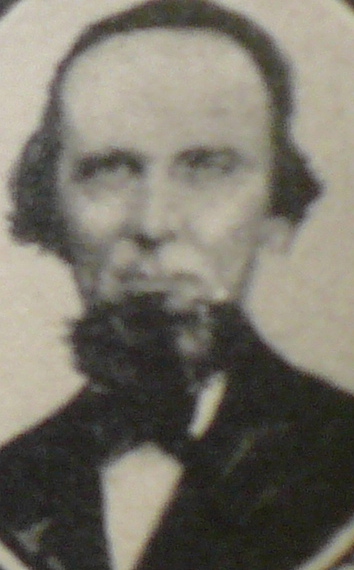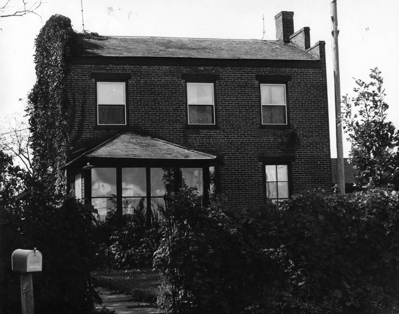Encyclopedia Dubuque
"Encyclopedia Dubuque is the online authority for all things Dubuque, written by the people who know the city best.”
Marshall Cohen—researcher and producer, CNN
Affiliated with the Local History Network of the State Historical Society of Iowa, and the Iowa Museum Association.
STEWART, William G.
STEWART, William G. (Jonesville, WV, July 10, 1813--Dubuque, IA, May 23, 1906). The son of William and Jane Stewart, both natives of Virginia, William had little formal education. In September, 1831, his father's family moved to Montgomery County, Missouri and he accompanied them. In the spring of 1832, he was employed by the government to assist in the removal of the Seneca, Delaware and other tribes from Ohio to their reservations about one hundred miles above Little Rock, Arkansas. (1)
Having heard of the LEAD mines near Galena, he visited them in October 1833 and remained until February, 10, 1834, when he came to Dubuque. He returned to Missouri the following summer. After remaining away about one year on account of sickness, he returned to Dubuque and engaged in farming and mining. (2) Wealthy when he arrived in Dubuque, Stewart was able to purchase nine hundred valuable acres north of Dubuque that were farmed using the modern techniques of his day. Stewart was financially involved with the DUBUQUE HARBOR COMPANY that was established to improve the lowlands along the riverfront. He remained an investor in this company until 1879 when he sold his interest.
Banks and RAILROADS were also of interest to Stewart. When the ILLINOIS CENTRAL RAILROAD was organized to extend its lines west of the MISSISSIPPI RIVER, Stewart served as a director of the line for several years. He was also associated with the DUBUQUE AND SIOUX CITY RAILROAD,CHICAGO, DUBUQUE AND MINNESOTA RAILROAD, and Iowa and Northern Railroads. (3) Stewart helped organize the DUBUQUE COUNTY BANK in 1875 and served as its first president.
Stewart was elected the first sheriff of Dubuque County in 1847 and remained in office for six years. He was elected and served four years on the Board of Supervisors and then in 1856 to one term in the Iowa Senate. In 1859 Stewart began his first term as the treasurer of Dubuque County, a position he held until 1873. (4)
In 1863, Stewart began renovating the ATHENAEUM theater. This was later purchased and became the DUNCAN-WALLER OPERA HOUSE. In 1874, while involved in efforts to fill a slough along the river, he was in charge of a train of 26 flat cars and a crew of 90 men. (5) In 1879 Stewart served as chairman of the Taxpayers' League, a group interested in lowering taxation of the city and county. (6) In the same year, he was appointed chairman of the Railroad Committee, charged with looking after the interests of the railroads in Dubuque and new businesses that might be encouraged to move to the city. (7)
Stewart's many contributions to Dubuque are often forgotten when compared to his donation in 1890 of several acres of land to the city with hope of creating a place where families could have outings. This donation was based on the extension of the street car line to the area. On October 22, 1890 Mayor Stewart, W. L. Allen and T. O. Swiney of the Allen and Swiney Company, with Marshall M. WALKER and Theodore RUETE examined the proposed route. (8) This donated land, then called Stewart Park, was later renamed UNION PARK.
The route of the NORTHWEST ARTERIAL was shifted to avoid removing Stewart's home on the west side of Kennedy Road just north of 32nd Street. The home was, however, was later demolished. The land in 2019 amounting to approximately four acres was listed for sale and was established by 2024 as the site of a series of stores.
---
Source:
1. The Iowa Legislature. "William G. Stewart," Online: https://www.legis.iowa.gov/legislators/legislator/legislatorAllYears?personID=5695
2. Ibid.
3. Ibid.
4. "Sketch of Hon. William G. Stewart," Dubuque Herald, October 29, 1880, p. 4. Online: https://news.google.com/newspapers?nid=uh8FjILnQOkC&dat=18801029&printsec=frontpage&hl=en
5. "Caught on the Fly," Dubuque Herald, February 26, 1874, p. 4. Online: https://news.google.com/newspapers?nid=uh8FjILnQOkC&dat=18740226&printsec=frontpage&hl=en
6. "Taxpayers' League," Dubuque Herald, April 25, 1879, p. 4. Online: https://news.google.com/newspapers?nid=uh8FjILnQOkC&dat=18790425&printsec=frontpage&hl=en
7. "Meeting of the Railroad Committee," Dubuque Herald, August 30, 1879, p. 4. Online: https://news.google.com/newspapers?nid=uh8FjILnQOkC&dat=18790830&printsec=frontpage&hl=en
8. "A Park Project Revived," Dubuque Daily Herald, October 23, 1890, p. 4. Online: https://news.google.com/newspapers?nid=_OG5zn83XeQC&dat=18901023&printsec=frontpage&hl=en
Oldt, Franklin. History of Dubuque County, Iowa. Chicago: Western Historical Company, 1880, p. 884-885
Portrait and Biographical Record of Dubuque, Jones and Clayton Counties, Iowa. Chicago: Chapman Publishing Company, 1894, p. 132



